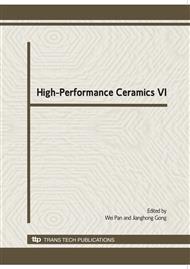p.705
p.710
p.714
p.717
p.719
p.723
p.727
p.731
p.735
Zircontes/Sulfates Composites: Perfect Combination of High- and Low-Temperature Protonic Conductors
Abstract:
Two typical classes of proton conductors, zirconates and solid acids (such as CsHSO4) or related sulfates, are intensively investigated recently. Based on the different proton-conducting mechanisms of zirconates and sulfates, we designed and fabricated Y2O3-doped barium zirconate/sulfates composites, aiming to make full use of the benefits, and eliminate the drawbacks of the two individual materials. The electrical conduction of the composite was studied by electrical and electrochemical methods. Microstructure of the composites was examined by SEM. Electromotive force (EMF) measurements were conducted under fuel cell conditions. The results indicated that small amount of sulfates was introduced at the grain boundaries of BaZr0.9Y0.1O2.95. The electrical conductivity of the composites was greatly improved and the total ionic transport numbers of the composites are more than 0.9 at 750 °C.
Info:
Periodical:
Pages:
719-722
Citation:
Online since:
March 2010
Authors:
Price:
Сopyright:
© 2010 Trans Tech Publications Ltd. All Rights Reserved
Share:
Citation:


